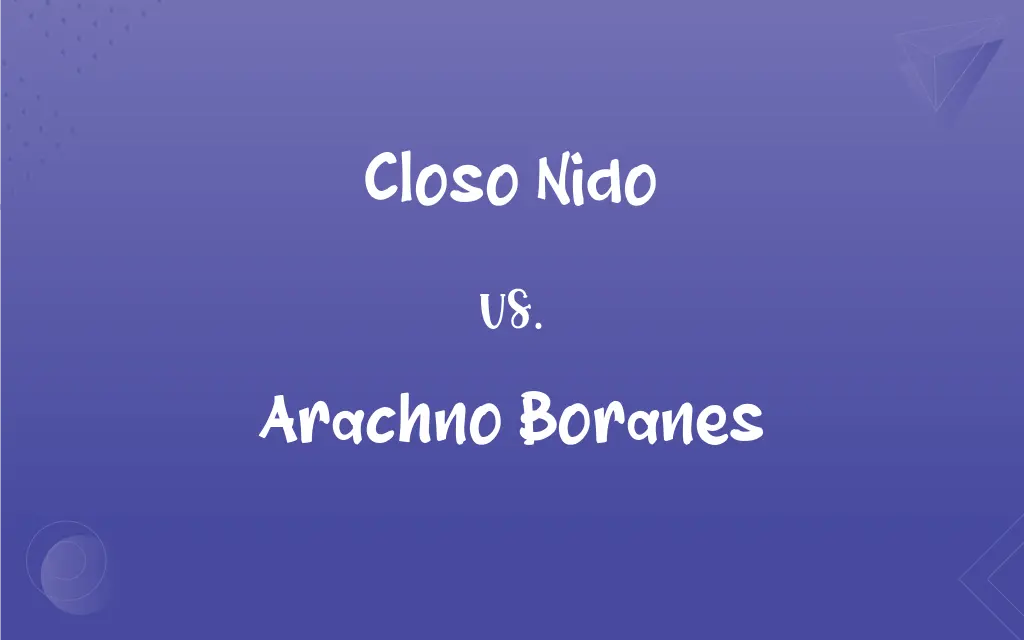Closo Nido vs. Arachno Boranes: What's the Difference?
Edited by Aimie Carlson || By Janet White || Published on November 23, 2024
Closo-nido boranes are fully closed boron-hydrogen compounds, while arachno-boranes have open cage structures with more missing vertices.

Key Differences
Closo-nido boranes and arachno boranes represent different classes of boron-hydrogen compounds, known as boranes, characterized by their unique structural geometries. Closo-nido boranes are known for their closed cage-like structures, encapsulating boron atoms in a polyhedral geometry. Arachno boranes, by contrast, are distinguished by their open cage structures, which resemble a spider's web in terms of their skeletal connectivity. The term "arachno" signifies the presence of additional vertices that are missing, compared to the closo-nido counterparts, leading to a more open and less symmetrical structure.
The structural distinction between closo-nido and arachno boranes is not merely aesthetic but has profound implications on their chemical reactivity and applications. Closo-nido boranes, being more closed and compact, exhibit a higher degree of stability and are less reactive in comparison to arachno boranes. On the other hand, the open structure of arachno boranes renders them more reactive and, therefore, more versatile in synthetic chemistry. The additional reactivity of arachno boranes makes them suitable for a range of chemical reactions and processes, including catalysis and organic synthesis.
Both closo-nido and arachno boranes belong to the larger family of boranes, their distinct structures confer different properties and uses. The closed, stable nature of closo-nido boranes contrasts with the open, more reactive framework of arachno boranes, making each class of compound suitable for different applications within chemical research and industry.
Comparison Chart
Structure
Closed cage-like structures.
Open cage structures with missing vertices.
Stability
Generally more stable due to closed structure.
Less stable due to open structure.
ADVERTISEMENT
Reactivity
Less reactive compared to arachno boranes.
More reactive due to open structure.
Geometrical Configuration
Represents a complete polyhedron.
Represents an incomplete polyhedron with gaps.
Chemical Applications
Used in applications requiring stability.
Used in synthetic chemistry for its reactivity.
Closo Nido and Arachno Boranes Definitions
Closo Nido
Closo-nido structures embody the concept of a complete borane polyhedron.
Researchers often study closo-nido boranes for their potential in material science.
Arachno Boranes
Arachno boranes exhibit higher reactivity.
The high reactivity of arachno boranes is valuable in the creation of new chemical bonds.
ADVERTISEMENT
Closo Nido
Closo-nido boranes are compounds with a closed boron-hydrogen structure.
The stability of closo-nido boranes makes them ideal for high-temperature applications.
Arachno Boranes
Arachno boranes are less stable due to their open cages.
The open cages of arachno boranes make them suitable for catalytic processes.
Closo Nido
Closo-nido refers to the complete polyhedral structure of boranes.
Closo-nido boranes exhibit a remarkable resistance to decomposition.
Arachno Boranes
Arachno compounds are characterized by their incompleteness.
Arachno boranes can act as intermediates in the synthesis of more complex boranes.
Closo Nido
Closo-nido compounds have symmetrical geometries.
The symmetry of closo-nido structures contributes to their unique chemical properties.
Arachno Boranes
Arachno boranes have open cage structures with missing vertices.
Arachno boranes' reactivity is exploited in organic synthesis.
Closo Nido
Closo-nido boranes are characterized by their closed cages.
Closo-nido boranes' closed cages are key to their stability.
Arachno Boranes
Arachno refers to the spider-web-like structure of these boranes.
The unique structure of arachno boranes allows for versatile chemical modifications.
FAQs
How does the stability of closo-nido compare to arachno boranes?
Closo-nido boranes are generally more stable than arachno boranes due to their closed structures.
What are closo-nido boranes?
Closo-nido boranes are boron-hydrogen compounds with closed cage-like structures.
What makes arachno boranes valuable in organic synthesis?
Their increased reactivity and ability to undergo modifications make them valuable.
How do arachno boranes' structures impact their chemical properties?
The open structure leads to less stability but greater reactivity and versatility.
What defines arachno boranes?
Arachno boranes are characterized by their open cage structures with missing vertices.
Are closo-nido boranes used in material science?
Yes, due to their unique properties and stability.
How do the open cages of arachno boranes affect their use in catalysis?
They make arachno boranes suitable for catalytic processes by allowing easier access to reactive sites.
Can arachno boranes act as intermediates in synthesis?
Yes, they are often used as intermediates due to their reactive nature.
Why are arachno boranes more reactive?
Their open structure and missing vertices increase their reactivity.
Can closo-nido boranes be used in high-temperature applications?
Yes, their stability makes them suitable for high-temperature uses.
Do closo-nido boranes have symmetrical geometries?
Yes, they typically have symmetrical, polyhedral geometries.
What role does symmetry play in the properties of closo-nido boranes?
Symmetry contributes to their chemical stability and unique properties.
How does the concept of a complete polyhedron apply to closo-nido boranes?
It signifies that their structure forms a complete, closed geometric shape.
Are there specific applications where closo-nido boranes are preferred?
Yes, in applications where chemical stability is paramount.
How does the incompleteness of arachno boranes' structure benefit chemical research?
It allows for the exploration of new reactions and synthetic pathways.
What research opportunities do arachno boranes offer?
They offer opportunities to develop new chemical reactions and synthesize novel compounds due to their open and reactive structure.
Why are arachno boranes considered versatile in synthetic chemistry?
Their structure allows for a wide range of chemical modifications and reactions.
What is the significance of the closed cage in closo-nido boranes?
It contributes to their stability and resistance to decomposition.
Can closo-nido boranes decompose easily?
No, they are resistant to decomposition due to their stable structure.
Do arachno boranes have any unique bonding characteristics?
Yes, their open structure allows for unique bonding opportunities not found in more closed boranes.
About Author
Written by
Janet WhiteJanet White has been an esteemed writer and blogger for Difference Wiki. Holding a Master's degree in Science and Medical Journalism from the prestigious Boston University, she has consistently demonstrated her expertise and passion for her field. When she's not immersed in her work, Janet relishes her time exercising, delving into a good book, and cherishing moments with friends and family.
Edited by
Aimie CarlsonAimie Carlson, holding a master's degree in English literature, is a fervent English language enthusiast. She lends her writing talents to Difference Wiki, a prominent website that specializes in comparisons, offering readers insightful analyses that both captivate and inform.







































































